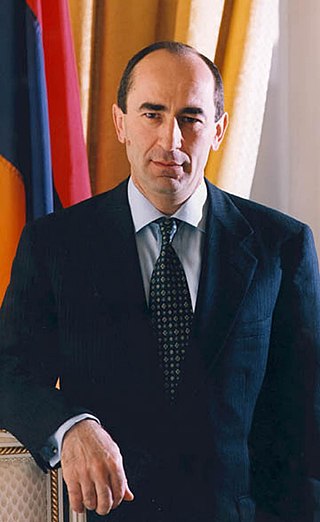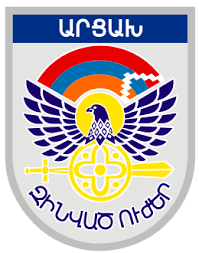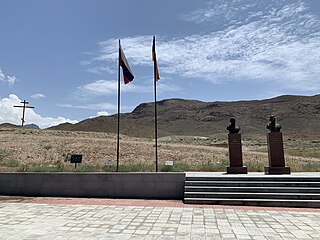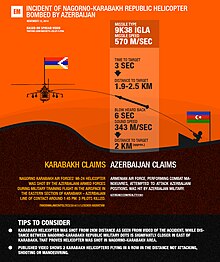
Robert Sedraki Kocharyan is an Armenian politician. He served as the President of the Nagorno-Karabakh Republic from 1994 to 1997 and Prime Minister of Nagorno-Karabakh from 1992 to 1994. He served as the second President of Armenia between 1998 and 2008 and as Prime Minister of Armenia from 1997 to 1998.

The Khojaly massacre was the mass killing of Azerbaijani civilians by Armenian forces and the 366th CIS regiment in the town of Khojaly on 26 February 1992. The event became the largest single massacre throughout the entire Nagorno-Karabakh conflict.

The First Nagorno-Karabakh War was an ethnic and territorial conflict that took place from February 1988 to May 1994, in the enclave of Nagorno-Karabakh in southwestern Azerbaijan, between the majority ethnic Armenians of Nagorno-Karabakh backed by Armenia, and the Republic of Azerbaijan with support from Turkey. As the war progressed, Armenia and Azerbaijan, both former Soviet republics, entangled themselves in protracted, undeclared mountain warfare in the mountainous heights of Karabakh as Azerbaijan attempted to curb the secessionist movement in Nagorno-Karabakh.

The Artsakh Defence Army was the defence force of the breakaway Republic of Artsakh. Established in 1992, it united previously disorganized defence units which were formed in the early 1990s.

The Nagorno-Karabakh conflict was an ethnic and territorial conflict between Armenia and Azerbaijan over the region of Nagorno-Karabakh, inhabited mostly by ethnic Armenians until 2023, and seven surrounding districts, inhabited mostly by Azerbaijanis until their expulsion during the 1990s. The Nagorno-Karabakh region was entirely claimed by and partially controlled by the breakaway Republic of Artsakh, but was recognized internationally as part of Azerbaijan. Azerbaijan gradually re-established control over Nagorno-Karabakh region and the seven surrounding districts.

The Battle of Shusha was the first significant military victory by Armenian forces during the First Nagorno-Karabakh War. The battle took place in the strategically important mountain town of Shusha on the evening of 8 May 1992, and fighting swiftly concluded the next day after Armenian forces captured it and drove out the defending Azerbaijanis. Armenian military commanders based in Nagorno-Karabakh's capital of Stepanakert had been contemplating capturing the town after Azerbaijani shelling of Stepanakert from Shusha for half a year had led to hundreds of Armenian civilian casualties and mass destruction in Stepanakert.
The Battle of Kalbajar took place in March and April 1993, during the First Nagorno-Karabakh War. It resulted in the capture of the Kalbajar District of Azerbaijan by Armenian military forces.

The Armenian Air Force is the air arm of the Armed Forces of Armenia formed by independent Armenia in 1992 in the wake of the dissolution of the Soviet Union. Outside its conventional name, it has also been referred to as the Aviation Department of the Armenian Armed Forces. It is organized and equipped principally to provide Armenian ground forces with tactical air support in the form of ground attack and airlift in mountainous terrain. It provided effective support during the battles with Azerbaijan in the Nagorno-Karabakh region from 1992 to 1994.

Karakend, or Berdashen (Armenian: Բերդաշեն, lit. 'village of the fortress' is a village in the Khojavend District of Azerbaijan, in the disputed region of Nagorno-Karabakh.

The 1994 Iranian Air Force C-130 shootdown occurred on March 17, 1994, when an Iranian Air Force C-130E military transport aircraft, carrying Iranian embassy personnel from Moscow to Tehran, was shot down by Armenian military forces near the city of Stepanakert in Nagorno-Karabakh, an area which had been under armed conflict since 1988. The 32 people on board were killed in the crash.
Operation Goranboy was a large-scale military offensive by Azerbaijan in the summer of 1992. Its aims were to take complete control of the entire territory of Nagorno-Karabakh and put a decisive end to the secessionist Nagorno-Karabakh Republic (NKR). This offensive is regarded as a successful breakthrough by the Azerbaijani Army and marked the peak of Azerbaijani success throughout the entire six years of the First Nagorno-Karabakh War.

On November 20, 1991, an Azerbaijani Mil Mi-8 military helicopter, carrying a peacekeeping mission team consisting of 13 Azerbaijani government officials, two Russian and one Kazakhstani Ministry of Internal Affairs officials, three Azerbaijani journalists and three helicopter crew was shot down amidst heavy fighting near the village of Berdashen, also known as Karakend, in Nagorno-Karabakh. All 22 people on board were killed in the crash. The incident is known in Azerbaijan as the ''Karakend tragedy''.
The 2010 Mardakert clashes were a series of violations of the First Nagorno-Karabakh War ceasefire. They took place across the line of contact dividing Azerbaijan and the ethnic Armenian military forces of the unrecognized but de facto independent Nagorno-Karabakh Republic. Both sides accused the other of violating the ceasefire regime. These were the worst violations of the cease fire in two years and left Armenian forces with the heaviest casualties since the Mardakert clashes of March 2008.
Armen Levoni Hovhannisyan was a junior sergeant in the Nagorno-Karabakh Republic Defense Army. He was posthumously awarded the Medal of Courage for noticing the intrusion of Azerbaijani subversive groups into the territory of the Nagorno-Karabakh Republic and organizing appropriate measures to move the enemy back to their starting positions.

Clashes on the Armenian–Azerbaijan border (Tavush–Qazakh) and the line of contact between the Nagorno-Karabakh and Azerbaijan started on 27 July 2014. Reported casualties of the clashes were some of the highest since the 1994 ceasefire agreement that ended the First Nagorno-Karabakh War.

The 2016 Nagorno-Karabakh conflict, also known as the Four-Day War, April War, or April clashes, began along the former Nagorno-Karabakh line of contact on 1 April 2016 with the Artsakh Defence Army, backed by the Armenian Armed Forces, on one side and the Azerbaijani Armed Forces on the other.

Adam Sahakyan was an Armenian sergeant of the Armed Forces of Armenia and the Nagorno-Karabakh Defense Army. In 2016 he was posthumously awarded the Hero of Artsakh military award, which is the highest honorary title of the self-proclaimed Republic of Artsakh.
The Ministry of Defence of Artsakh was a government agency of the unrecognized Republic of Artsakh. It was the executive body in implementing defence policies of the Artsakh Defence Army. The final minister of defence was Lieutenant General Kamo Vardanyan. Following an Azerbaijani assault on 19 September 2023, Artsakh agreed to dissolve itself by 1 January 2024.
Karen Abrahamyan is a politician and general, who is the former Minister of Defence of Artsakh.

On 9 November 2020, a Russian Mil Mi-24 helicopter was shot down by the Azerbaijani Armed Forces during the Second Nagorno-Karabakh War. It was shot down near Yeraskh, in Armenia, a few kilometers away from Azerbaijan's Nakhchivan Autonomous Republic, as a result of fire from the ground from man-portable air-defense system. Two of the crew members died, while another was injured as a result of the attack. Azerbaijani authorities soon issued a statement of apology, saying that the shootdown happened by mistake and offered compensation.














